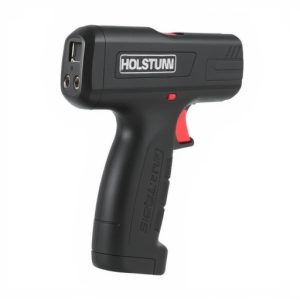Electrical Pulse Frequency: Unlocking Stun Gun Efficiency
Stun guns operate by emitting brief, high-voltage, low-current electrical pulses through two electro…….
Stun guns operate by emitting brief, high-voltage, low-current electrical pulses through two electrodes on their surface, which travel to the target's skin and disrupt nerve impulses, causing involuntary muscle contractions and temporary paralysis. Their effectiveness depends on factors like pulse intensity, duration, and area of contact, with modern models utilizing advanced circuitry and capacitor technology for efficient energy release. The critical component is pulse frequency, which determines how deeply the shock penetrates and ensures minimal harm to bystanders while subduing attackers.
Stun guns, also known as electronic control devices (ECDs), have become popular for personal protection. But do you know how these devices actually work? This article delves into the intricate mechanisms of stun guns, focusing on the critical role of electrical pulse frequency in their effectiveness. We’ll explore the basic operation, key components, and the science behind different pulse frequencies. Understanding these aspects provides valuable insights into not only how stun guns function but also the safety considerations and future innovations shaping this technology.
- The Basic Mechanism of Stun Guns
- – Explanation of stun gun functionality
- – Key components and their roles
- Electrical Pulse Frequency: A Cornerstone of Stun Gun Effectiveness
The Basic Mechanism of Stun Guns
Stun guns, also known as electroshock weapons, operate on a simple yet powerful principle—delivering an intense electrical pulse to temporarily incapacitate a target. The basic mechanism involves generating a high-voltage, low-current electric discharge, typically in the form of a short burst of electricity. This pulse is then directed towards the body of the intended target through metal probes or electrodes.
The electrical current disrupts the normal functioning of the nervous system, specifically targeting muscles and causing involuntary contractions. The result is a stunning effect, rendering the individual immobile for a brief period. The key to this process lies in the frequency of the pulse—a carefully calibrated parameter that ensures maximum effectiveness without causing permanent harm. How does a stun gun work? It’s all about this precise balance between delivering a powerful shock and maintaining control to prevent long-term damage.
– Explanation of stun gun functionality
Stun guns, also known as electronic control devices (ECDs), operate on a simple yet powerful principle: delivering electrical pulses to disrupt muscle control in an opponent. When activated, the stun gun emits a brief, high-voltage, low-current electrical pulse through two electrodes. This pulse travels from the stun gun’s surface to the target’s skin, and then into their body. The result is a strong neuromuscular disruption that causes the muscles to contract uncontrollably, temporarily paralyzing the individual.
The effectiveness of a stun gun depends on several factors, including the intensity and duration of the pulse, as well as the area of contact. Modern stun guns use advanced circuitry and capacitor technology to store and release energy quickly and efficiently, ensuring a powerful and reliable shock. This makes them a popular choice for self-defense purposes, providing individuals with a non-lethal way to subdue an assailant.
– Key components and their roles
Stun guns, also known as electronic control devices (ECDs), operate on a simple yet powerful principle: delivering electric shocks to immobilize a target. Understanding how they work involves grasping key components and their functions. At the core is the circuit board, which controls the flow of electricity and generates the high-voltage, low-current pulse. This pulse is then transferred through conductive parts like wires and electrodes, ultimately making contact with the subject. The electrical pulse frequency plays a crucial role in stun gun effectiveness; it’s typically measured in kilohertz (kHz). Higher frequencies can penetrate clothing better, while lower frequencies may be more effective for shorter-range, intense shocks.
The power supply, usually one or more high-capacity batteries, stores the energy required to generate these electric pulses. A safety switch, often triggered by pressing a trigger mechanism, controls when this stored energy is released. The electrodes, typically metal prongs or pads, are designed to make good contact with the target’s skin, conducting the electrical current and delivering the stun. The design of these components, from the circuit board to the electrode shape, significantly influences the stun gun’s performance, safety, and impact on the subject.
Electrical Pulse Frequency: A Cornerstone of Stun Gun Effectiveness
Electrical Pulse Frequency plays a pivotal role in determining the effectiveness of a stun gun. These devices function by delivering an electric shock to incapacitate a target, and the frequency of the electrical pulse is a key factor in achieving this. Higher pulse frequencies can penetrate the body’s natural defense mechanisms more effectively, ensuring that the shock disrupts nerve impulses and causes muscle spasms. This results in temporary paralysis, allowing the user to subdue an attacker or defend themselves.
Understanding how a stun gun works involves recognizing that these devices generate electric pulses through specialized circuitry. These pulses are then transmitted through electrodes, which make contact with the target’s skin. The frequency of these pulses directly influences the depth and intensity of the shock experienced by the target, making it crucial for achieving the desired level of incapacitation while minimizing potential harm to bystanders or users.
Stun guns, through their intricate interplay of electrical pulses and key components, effectively disable opponents. The frequency of these electrical pulses plays a pivotal role in determining the stun gun’s effectiveness. Understanding this mechanism, particularly the pulse frequency, is crucial for both users and developers looking to enhance these devices, ensuring they work as intended during critical situations. By delving into these intricacies, we gain valuable insights into how stun guns function and contribute to personal safety and security.


